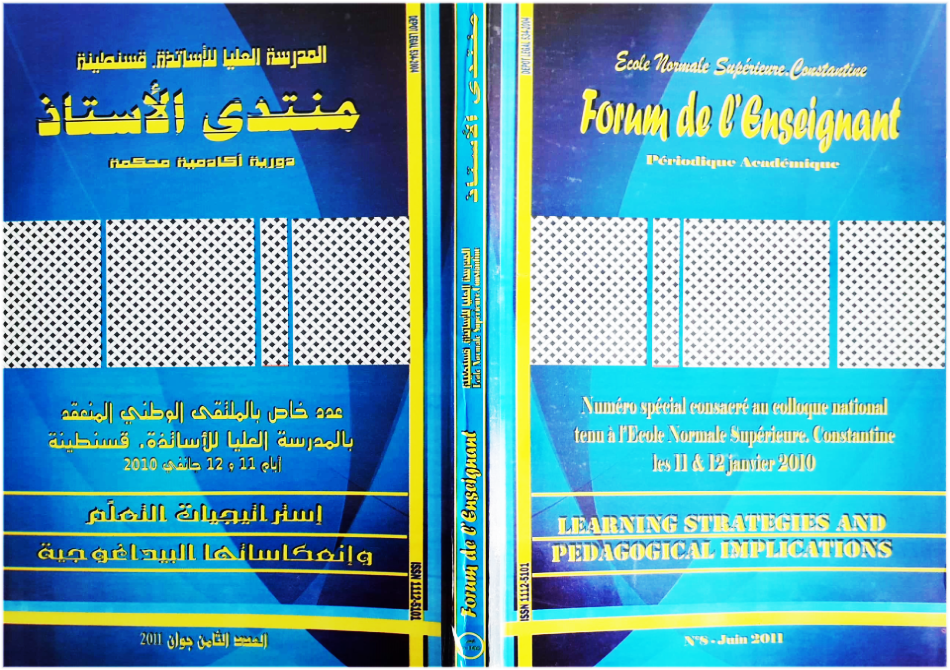Vocabulary Teaching Techniques and Learning Strategies at Middle School Level
Résumé
Beginners often manage to communicate
in English using individual words; and
they can most of the time convey meaning
without necessarily having acquired
grammar. This is evidence that in learning
a language, grammar is not sufficient and,
thus, more importance has to be given to
vocabulary. However, vocabulary
instruction and learning have always been
secondary to grammar, and vocabulary
has been considered as only a means and
not an end in language teaching and
learning. Classroom blackboards are often
littered with masses of new lexical items
and learners often compile word lists
rarely helpful in their learning. Teachers’
techniques most often do not match their
pupils’ different learning styles and the
different strategies the latter utilize when
encountering new vocabulary. In this
article we attempt to show the relationship
between middle school teachers’
techniques in presenting vocabulary and
the strategies pupils use in order to deal
with new vocabulary. At the outmost, we
will show the degree of correlation
between the teachers’ techniques and the
learners’ strategies and give some
directions to help develop the teachers’
techniques in order to meet the learners’
strategies and styles in learning vocabulary.
Téléchargements
Références
Allen, V.F. (1983). Techniques in Teaching Vocabulary. Oxford: Oxford University Press
Bunker, E.L. (1988). Toward comprehensive guidelines for the preparation of materials in
English for EFL adults with limited education. M.A. Thesis, Linguistic Department,
Brigham Young University. Provo, Utah.
Chaudron, C. (1982). “Vocabulary elaboration in teachers’ speech to L3 learners”.
Studies in
Second Language Acquisition, 4, 2,170-180.
Fadel, M.R. (2005). Storytelling and Vocabulary Acquisition at the Elementary Level.
Unpublished magister thesis, Mentouri University, Constantine.
Faerch, C. and G. Kasper. (1980). “Processes in Foreign Language Learning and
Communication”. Interlanguage Studies Bulletin, 5, 47-118.
Gairns, R. and S. Redman. (1986). Working with Words. A guide to teaching and learning
vocabulary. Cambridge: Cambridge University Press.
Harmer, J. (1991). The Practice of English Language Teaching. Longman
Haycraft, J. (1978). An Introduction to English Language Teaching. London: Longman
Naiman, N., M. Froehlich, H. Stern, and A. Todesco. (1978). “The Good Language
learner”. Research in Education, 7. Toronto: Ontario. Institute for Studies in
Education.
O'Malley, J.M. and A.U. Chamot. (1990). Learning Strategies in Second Language
Acquisition. Cambridge: Cambridge University Press.
Pickett, G. (1978). The Foreign Language Learning Process. London: The British Council.
Rivers, W.M. (1968). Teaching Foreign language Skills. University of Chicago Press.
Second Edition, 1981.
Rivers, W.M. (1983). Communicating Naturally in a Second Language. Cambridge:
Cambridge University Press.
Tarone, E. (1980). “Communication strategies, foreigner talk and repair in
interlanguage”.
Language Learning 30, 417-31.
Upshaw, S. (1995). “Helping Students Develop Personal Vocabulary
Strategies”.Proceedings
of the Second EFL Skills Conference. Cairo. Egypt. 247-250.
Wilkins, D. (1972). Linguistics in Language Teaching. Edward Arnold.





